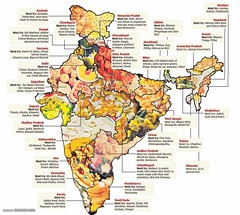The cuisine of India is characterized by the use of spices, herbs and vegetables grown in India and also for the widespread practice of vegetarianism. Each family of Indian cuisine is characterized by a wide assortment of dishes and cooking techniques, says Wikipedia.
Around 7,000 BC, sesame, eggplant, and humped cattle had been domesticated in the Indus Valley.[12] By 3000 BC, turmeric, cardamom, black pepper and mustard were harvested in India.[13]
In Vedic (ancient) times, a normal diet consisted of fruit, vegetables, meat, grain, dairy products and honey.[14]
Over time, some segments of the population embraced vegetarianism, due to the ancient Hindu philosophy of ahimsa, which forbids killing or injuring of living beings.[15]
Buddhism, among several other beliefs and practices borrowed vegetarianism from Hinduism to embrace Ahimsa.
invasions from Central Asia, Arabia, the Mughal empire, Persia, and elsewhere had a deep and fundamental effect on Indian cooking. Influence from traders such as the Arab and Portuguese diversified subcontinental tastes and meals. As with other cuisines, Indian cuisine has absorbed New World vegetables such as tomato, chilli, and potato, as staples.
The popularity of curry, which originated in India, across Asia has often led to the dish being labeled as the "pan-Asian" dish.[32] Curry's international appeal has also been compared to that of pizza.[33]
Though the tandoor did not originate in India, Indian tandoori dishes, such as chicken tikka made with Indian ingredients, enjoy widespread popularity.[34]
Historically, Indian spices and herbs were one of the most sought after trade commodities. The spice trade between India and Europe led to the rise and dominance of Arab traders to such an extent that European explorers, such as Vasco da Gama and Christopher Columbus, set out to find new trade routes with India leading to the Age of Discovery.[4]
skip to main |
skip to sidebar
For students and parents who love education and exploration of the social sciences . . .
Search This Blog
Followers
Blog Archive
-
▼
2010
(346)
-
▼
March
(51)
- What's surprising and significant in the compariso...
- Thurs, Ap 1: Vietnam plus Korea map quiz as well a...
- Korea: another nation divided between communist an...
- Orienting ourselves to the Pacific rim nations
- Review of Presidents in Vietnam project
- Thanks for supporting the Class of 2013 Magnet Tal...
- Informal presidential review . . .
- Vietnam: 58,000 US dead, some 4 million Vietnamese...
- 1972, South Vietnam: the Victims Of War
- Shot Heard Around The World: Execution of a Viet C...
- Due Thurs: Colorful map of Vietnam
- Vietnam and the Chinese, French and the US: a hist...
- In-class project: Four presidents and US involveme...
- The largest and most technologically advanced ship...
- Indie work: briefly compare the war in Iraq and Vi...
- Vietnam veteran interview due Mon, Ap 5; 15 pts
- Washington to Hanoi: Vietnam review
- Sitar & Tabla: the unusual musical instruments of ...
- Indie work deadline Sun, Mar 14, noon, for this 9 ...
- Eric Johnson's Gandhi project: effective digital d...
- Freshman Talent Show: Wed, Mar 24, 6:30 pm, PAC; i...
- Shreveport's Hindu Cultural Center since 2006
- Western world stress relief: Hatha Yoga from India
- Gandhi's tactics: use media, the law, Christianity...
- Watching the movie Gandhi for useful quotes . . .
- India: land of many cuisines
- Gandhi map project due Thurs; 15 pts
- Sari vs kimono and other indie comparison topics
- The 78-year journey of Mohandas Karamchand Gandhi
- Mumbai / Bombay: one of the world's most populous ...
- Slumdog Millionaire and other recommended movies o...
- India: Land of Curry, land of Hinduism
- Indie work: comparison essays on . . .
- The Ankh: symbol of eternal life
- March named for Roman god of war & fertility: Mars
- Pharaoh Hatshepsut, female ruler about 1500 BCE of...
- Egyptian overview: from the Pharaonic period to th...
- What to know on a map of Aegypticus (the Roman/Lat...
- A highlighter: the tool to use as you review notes...
- Egypt map and textbook activities
- The Nile
- West African music
- West African studies
- Walk like an Egyptian, The Bangles
- Gift of the Nile: Egypt
- Abu Simbel: massive mountainside temples in Southe...
- Memphis was the first capital of Egypt
- The columns of the Luxor Temple, near Karnak
- The Great Pyramids were built during the Old Kingdom
- Sphinxes
- The Great Pyramid of Giza (of Khufu), the Great Sp...
-
▼
March
(51)

